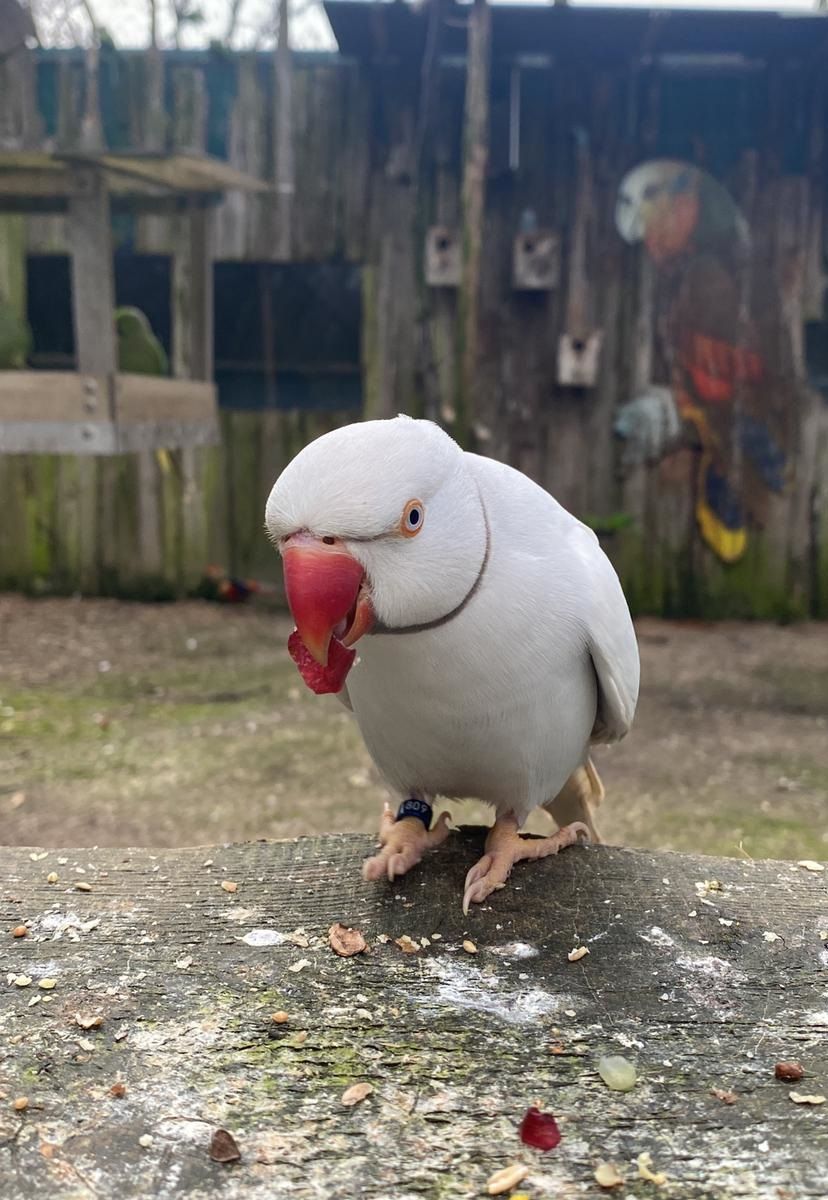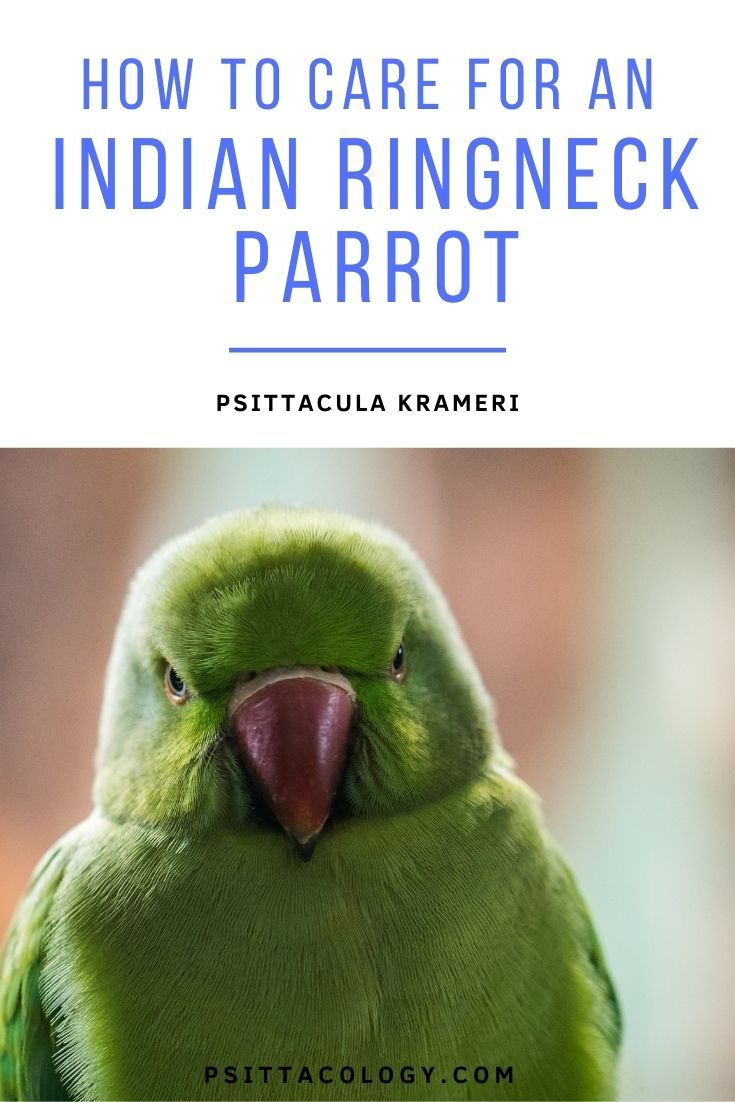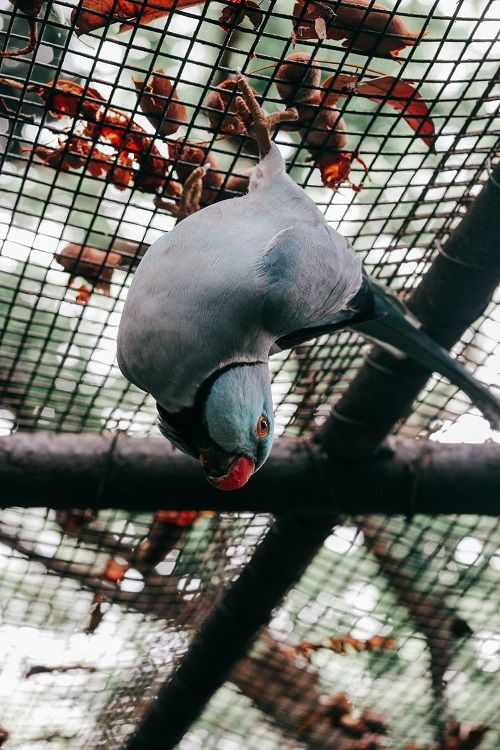Are you thinking of adding an Indian ringneck parrot (also known as rose-ringed parakeet) to your family? Not surprising, as these talkative birds can make great pets for the right owner. But what will your new feathered friend need to thrive in your home?
Keep reading for everything you need to know about Indian ringneck parrot care and keeping these colorful parrots happy and healthy!
| Name(s) (common, scientific) | Indian ringneck parrot, rose-ringed parakeet, Psittacula krameri, Alexandrinus krameri |
| Natural habitat | Varied; savannah, grassland, shrubland, forest, wetland |
| Adult size | Up to 40 cm/16″ in length, 130 grams in weight |
| Lifespan | 15-25 years, up to 30 |
| Noise level | Medium |
This post contains affiliate links. If you make a purchase, a small percentage will go directly to Psittacology at no additional cost to you. Thank you for supporting Psittacology!
Indian ringneck parrot appearance
Rose-ringed parakeets are naturally green in color, with a bright red beak. They’re typically parakeet-shaped, with their tails sometimes reaching almost the same length as their slender bodies. Their total length of around 40 cm/16″ and weight of around 130 grams make them medium-sized parrots.
The common name “ringneck” was derived from the fact that the males of the species do indeed sport a black to pink ring around their neck, which extends to the cheeks and stops at the beak.
There are four subspecies of Indian ringneck parrot:
- Psittacula krameri krameri (African Indian ringneck)
- Psittacula krameri parvirostris (Abyssinian Indian ringneck)
- Psittacula krameri manillensis (Indian ringneck)
- Psittacula krameri borealis (Boreal Indian ringneck).
The latter two, the Asian subspecies, are larger than their African cousins, although the differences are pretty small.
Did you know? A 2019 DNA study led the authors to suggest that the taxonomy of the genus Psittacula, of which the Indian ringneck forms part, should be changed. According to their research, Psittacula krameri should receive the new scientific name of Alexandrinus krameri, along with some other pretty major revisions. However, I’ll keep using Psittacula here for now, as not many sources have caught on yet.
Braun et al., 2019
Male vs female Indian ringneck
Determining the gender of an Indian ringneck parakeet is not considered possible before the bird has reached maturity at around three years, unless you go for a DNA test.
In adults, there are some good indicators:
- The neck ring that earned these parakeets their name only shows up on male Indian ringnecks. If yours has a pronounced ring, that’s a male. Again, though, this trait can take quite a while to show up and never do in albino or lutino ringnecks.
- Males will flirt by slightly extending their wings and tail feathers, displaying and bopping around.
- Adult females tend to be a bit stockier and less dainty than males. Their tail feathers tend to be a little shorter.
Indian ringneck parrot colors
This long history in aviculture has given breeders plenty of time to develop a wide range of rose-ringed parakeet colors through selective breeding.
You’ll now find these parrots in a veritable rainbow of different shades, including natural green, yellow, different shades of blue and violet-ish, white and combinations where the head is a different color than the body.
Did you know? There is another species in the genus Psittacula that can look confusingly similar to the Indian ringneck to the untrained eye: the Alexandrine parakeet, Psittacula eupatria. Look for a slightly heftier bird with a bigger beak and red shoulder patches.

Indian ringneck parrot natural habitat
Natural habitat
The four subspecies of Psittacula krameri together cover quite a wide natural range. The African subspecies are found in a belt that ranges across Central Africa, from Senegal on the western end to Ethiopia on the eastern side. They reach into Egypt in the north and Uganda in the south.
The Indian subspecies is obviously mostly associated with the country of India, but it actually extends from Afghanistan in the west to as far east as Vietnam.
This parrot is not very picky when it comes to its habitat, which is probably why it’s so widespread today. It’s listed as Least Concern by the IUCN, which notes that it naturally inhabits desert-ish grasslands and savannahs, as well as more shrubby and even forested areas and wetlands.
Their favorite environment, though? Cities and farmland, where food is very easy to find.
Introduced habitat
The perfect storm of the Indian ringneck parrot’s hardiness, adaptability, love for human food and the pet trade have made this species incredibly invasive. Feral populations can be found around the world, causing trouble for native species in many areas.
I’ve seen wild ringnecks in all the countries I’ve lived in (The Netherlands, England and Spain, the latter of which has banned the species as a pet to try and prevent further spread), even though they’re not native to any of them.
London in particular has huge populations. Going to Hyde Park to feed apples to the ringnecks is now a favorite tourist activity!
Did you know? As described in the article on ringneck parrot history, this bird has been a favorite pet among humans since the times of the Ancient Romans and Greeks.

Indian ringneck parrot diet
Wild diet
In the wild, this herbivorous species mostly consumes different types of seeds, making it a granivore. Indian ringneck parrots will also eat berries and fruits, nuts, flower buds and even the occasional insect.
Ringnecks are also considered an agricultural pest in some areas, as flocks raid cereal grain and legume crops, orchards and more. I noticed in London that they’re also not opposed to visiting bird feeders!
Domestic diet
What should you feed your pet Indian ringneck parakeet? It’s important to keep their natural diet in mind, but I want to stress that you shouldn’t let this trick you into thinking they need to be fed a seed diet.
Unfortunately, we don’t have access to the same variety of seeds these birds eat in the wild, and dried parrot seed mixes can lead to malnutrition if you feed them exclusively.
The article on parrot diet contains pretty much everything you need to know, but here’s a short summary. Try combining the following for a healthy Indian ringneck parrot:
- A high-quality pellet as a staple.
- Daily servings of fresh vegetables and leafy greens.
- A high-quality parrot seed mix.
- Fresh fruits.
- Sprouted seeds.
- Cooked grains like rice and pasta.
- Foraged foods like wild grasses, certain flowers and fresh parrot-safe branches.
Did you know? I found a charming scientific study concluding that rose-ringed parakeets actually have a foot preference for holding their food. There were more left-footed birds than right-footed ones! Which foot does your parrot prefer?
Randler, Braun & Lintker, 2011

Indian ringneck parrot housing
As with any parrot, when it comes to choosing a cage for your Indian ringneck, it’s important to go as large as possible. These are medium-sized birds with long tails that need quite a bit of space to stretch their wings.
The exception would be if you leave the cage door open all day so your parrot can roam free, in which case you can stick to the minimum cage size of around 2 x 2 x 3 ft (60 x 90 cm).
Provide various perches made of natural wood, especially near the top of the cage. Make sure your Indian ringneck has access to multiple food and water stations. And don’t forget the toys: we’ll discuss those below in the section on enrichment!

Indian ringneck parrot temperament
Oh boy, where do I start?! Indian ringneck parrots are not meant for those who live a busy life but still expect a cuddly bird. They’re extremely intelligent and demanding, get bored easily and are known for getting nippy and destructive if left to their own devices.
If you have the patience and time to hang out and play with, as well as train your Indian ringneck, then you’ve got a fantastic bird on your hands. They can be extremely loving and loyal with a great love for neck scratches. They’re not shy at all, with the males especially being known for their fancy, seemingly arrogant strut.
A well-socialized ringneck will enjoy forming part of your family, hanging out and inspecting everything that goes on in the house. Everyone should handle and feed the bird on a regular basis, because they do have a tendency to bond with one person and become aggressive towards others.

Indian ringneck parrot enrichment
As you’ve probably included from the section on temperament above, it’s extremely important to keep an Indian ringneck parrot’s smart brain busy. A bored bird is a recipe for disaster!
So what kind of enrichment should you consider? Here are just a few examples:
- Training time. A double whammy, especially with bolder species like ringnecks! Spending time training your bird to do tricks or to talk not only stimulates desirable behaviors, but also strengthens your bond.
- Out of cage time. Don’t let your parrot wither away in its cage. Set up a nice playground on top of the cage or another surface so it can fly around and see a bit more of the world. Be sure to parrot-proof the room and supervise your bird.
- Toys. No one can spend 24/7 with their bird. Even Indian ringnecks that aren’t kept alone need plenty of entertainment in their cage. Rotate a variety of parrot-safe toys on a weekly basis to keep things interesting.
- Chewing. Almost all parrots love to chew and ringnecks are no exception. Provide soft wood toys, natural perches and branches, calcium blocks, cuttlebone and everything you can think of for your feathered friend to destroy.
- Foraging. Why settle for throwing some food into your parrot’s bowl and leaving it at that? Feeding time is much more interesting for your ringneck if it has to work for its food.
Are Indian ringneck parrots loud?
Well… they’re not quiet, that’s for sure. Loudness is a relative concept for parrots, as all species produce a lot of noise, but Indian ringnecks tend to fall somewhere in the middle. Their flock call can be very piercing and the boys especially love to spend much of the day chattering and talking.
If you’re sensitive to noise, these birds are not for you. You can choose one of the quieter pet birds out there or, if you’re very intolerant, will have to consider a different type of pet.
Can Indian ringneck parrots talk?
Yes! The males (and sometimes females) of this species are pretty talented talkers. If you train your Indian ringneck parrot well, it can end up acquiring an impressive vocabulary of phrases, whistles and sounds.
Indian ringneck parrot safety & emergencies
The unfortunate reality with parrots like this one is that because they’re so curious, they’re also pretty prone to getting themselves in trouble. This is why it’s extremely important to have the number for an avian vet on hand.
All rooms your Indian ringneck has access to should be parrot-proofed: no open windows, everyone is aware of where the bird is at all times, no toxic foods or plants, no perfume, cigarette smoke or other fragrances.
Visit your vet on at least a yearly basis for a check-up, starting when you bring your Indian ringneck parrot home. Make sure you know about emergency parrot care.
Frequently asked questions
As described in the article about Indian ringneck parrot lifespan, these birds can live for up to 30 years with the right care. Getting one is a big commitment!
The black ring on male Indian ringnecks develops at about a year and a half of age. The pink and blue coloration around it can take up to double that time to show up.
No, you shouldn’t keep your Indian ringneck with a budgie. They’re much too big to live with parakeets: it’s an accident waiting to happen.
If you have any more questions about Indian ringneck parrot care or want to share your own experiences with these talkative parrots, don’t hesitate to leave a comment below!
Sources & further reading
- Braun, M. P., Datzmann, T., Arndt, T., Reinschmidt, M., Schnitker, H., Bahr, N., … & Wink, M. (2019). A molecular phylogeny of the genus Psittacula sensu lato (Aves: Psittaciformes: Psittacidae: Psittacula, Psittinus, Tanygnathus,† Mascarinus) with taxonomic implications. Zootaxa, 4563(3), zootaxa-4563.
- Menchetti, M., Mori, E., & Angelici, F. M. (2016). Effects of the recent world invasion by ring-necked parakeets Psittacula krameri. Problematic Wildlife: A cross-disciplinary approach, 253-266.
- Randler, C., Braun, M., & Lintker, S. (2011). Foot preferences in wild-living ring-necked parakeets (Psittacula krameri, Psittacidae). Laterality, 16(2), 201-206.


Very informative. Thank you.
Great article. I like to say that Indian Ringnecks are like a bigger version of a Green Cheek Conure. Watching their body language is very important and if you miss a cue you are going to get nipped. An absolutely great mid level parrot. If you like birds that act like a clowns this might be the species for you.
Thanks for sharing! I agree. Definitely a great choice if you’ve got some experience, they’re hilarious.
Good article.
But do you know that keeping as pet is illegal under Indian Law. Article should be made after confirming the all the details.
Thanks! This article wasn’t written with an Indian audience in mind 🙂 but I appreciate the information nonetheless.
I have a Indian ringneck. I adopted him about 2 years ago. So he’s about 4 years old now.
Anyway, we got a budgie in February so he’d have a little friend.
After reading this article and the last part said: Do not keep Budgie and Ringneck together.
My wife picked the budgie and she wanted/chose the smallest and youngest one they had. He barely had any tail features yet!
We brought him home and no, we did not keep them in the same cage.
We let Doli the Ringneck see the new commer for 1 day before we let the little budgie out of his cage.
Well immediately the budgie flew directly next to Doli. Budgie wanted to make friends and Doli not so much.
Fortunately Budgie, although very small. Was and is very quick and a very good flyer.
Doli did chase Budgie for maybe 6-8 weeks.
It’s June now and they get along swimmingly.
Budgie follows Doli everywhere and is saying and making many of the same sounds as Doli.
When it’s treat treat time. Doli and Budgie eat together out of the same food bowl.
The only time now Doli gets mad at Budgie is when Budgie lands on his tail or trys to pull it.
They still sleep in separate cages, but I would have no problem with Budgie sleeping in the same cage with Doli now.
After all. If I haven’t let Doli out yet and Budgie is out of his cage.
Budgie will be found inside Doli’s cage.
Hey! Thanks for sharing. Yeah, I don’t recommend keeping budgies and ringnecks together. I’m glad it worked out in your case, but since a ringneck can so easily get a budgie toe or beak, it’s a bit of a “do not try this at home” situation!
Hope things continue to go well for Budgie and Doli, they do sound like a sweet pair. 🙂
Hi, I found your article very helpful as I knew nothing about parrots and now a female feral parrot of this kind is visiting my bird feeder in Golden, CO. She seems to hang out with a rowdy gang of blue jays, and has been spotted in a wide area at other feeders. Do you have any suggestions on how to catch this bird? We all foresee a bad end from either predators or the first hard freeze if she cannot be rescued.
Thank you.
Hey! That’s interesting, I have no idea if this area is known for feral Indian ringnecks. They can actually survive in areas that get frost fine in many cases, though I take it you think it’s an escaped pet? I do think they’re legal in most states, so it is possible. I’d check local Facebook groups, like parrot groups for your state and neighborhood groups. Do ask for proof before you give the bird to someone.
In the meantime, you could set up a good old-fashioned parrot trap: an open cage with food, a mirror and a recorder playing Indian ringneck sounds inside. An alternative would be a bird net, but I doubt you’ve got one of those lying around, plus if you don’t get it right the first time the bird is unlikely to come back.
I would love an update if you manage to catch her. Fingers crossed and I hope she’ll be alright. Good luck!